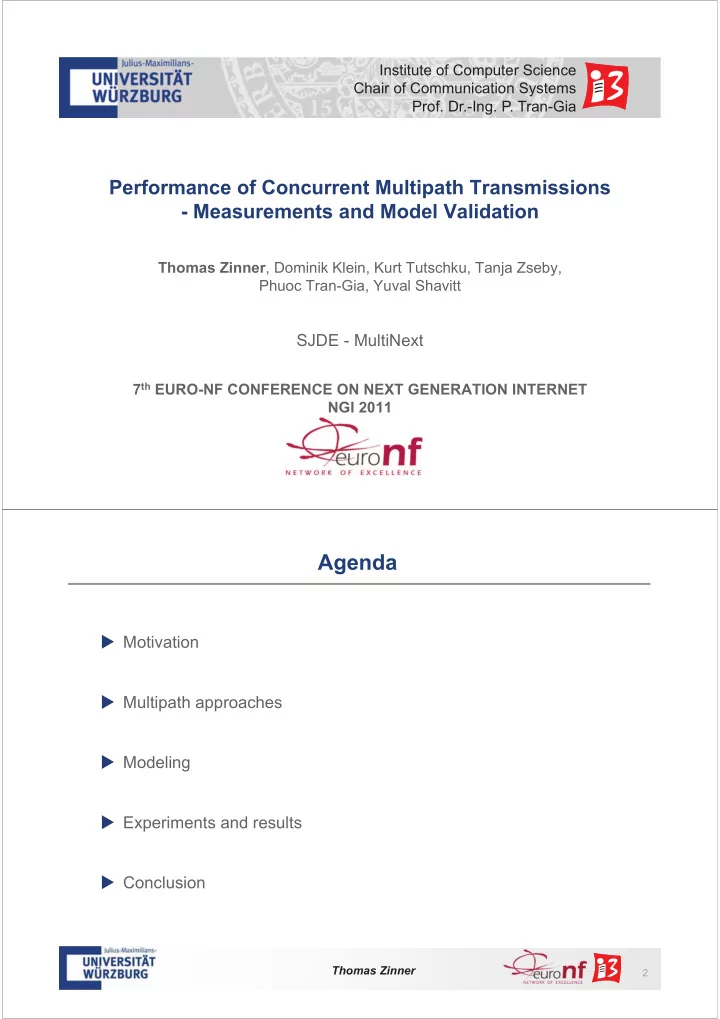

Institute of Computer Science Chair of Communication Systems Prof. Dr.-Ing. P. Tran-Gia Performance of Concurrent Multipath Transmissions - Measurements and Model Validation Thomas Zinner , Dominik Klein, Kurt Tutschku, Tanja Zseby, Phuoc Tran-Gia, Yuval Shavitt SJDE - MultiNext 7 th EURO-NF CONFERENCE ON NEXT GENERATION INTERNET NGI 2011 Agenda � Motivation � Multipath approaches � Modeling � Experiments and results � Conclusion Thomas Zinner 2
MOTIVATION Thomas Zinner 3 Motivation � Concurrent Multipath Transmission � Resource pooling ! Parallel usage of resources ! Forming a virtualized single "transport resource# � Aiming for � Improved resilience � High capacity (e.g. for video streaming) � New business models e.g. ! Combine multiple operators ! Dynamic resource selection Thomas Zinner 4
Concurrent Multipath Transfer Logical topology Aim: Very high and reliable transmission between two end hosts Solution: Transport Virtualization: Combine multiple paths (even from different providers) Aim: Very high and reliable throughput between two end hosts Routing topology Remark: Multihomed end user devices (e.g. Smartphones, of provider II Notebooks,$) in general also allow multipath transmissions pooled transport pipe Routing topologies of provider I POP Superset of available physical resources Thomas Zinner 5 Performance Issues re-sequencing ? different path delays out-of-order arrivals � Packets arrive out of order at the destination � Re-sequencing necessary � How can we calculate the ratio of reordered packets (and then do proper dimensioning)? Thomas Zinner 6
MULTIPATH APPROACHES Thomas Zinner 7 Multipath Approaches � Current multipath transmission approaches � Transport virtualization (Tutschku et al.) � Multipath-TCP (Trilogy/IETF) � Concurrent multipath transfer using SCTP (Iyengar et al.) � Load balancing in MPLS (X. Hesselbach et al.) � pTCP (Hsieh et al.) � Reordering in OBS networks (Gunreben et. al) � $ � Common problems: out-of-order arrivals � Our solution: re-sequencing buffer � Buffer dimensioning (metric for out-of-order packets) � Influence on the E2E delay and throughput of pooled resources � Selection strategies Thomas Zinner 8
MODELING Thomas Zinner 9 Transmission Model Data � stream � divided � at � ingress � into � Data � stream each � provider � will � offer � a � set � n i of � parallel � paths p 1,1 segments � with � k parts (i = � 1 m) overlay � 1 � p 1,n1 � Scheduling? 1 Assumption: � use � k parallel � paths � on � m 2 overlays � k k parts � have � � src dst � k paths arrived 1 k � 1 Resequencing � buffer � k of � size � L p m,1 k parts � are � send � in � overlay � m � Reassemble � data � stream � from � parallel � at � time � t � obtained � parts p m,nm � � � � � Buffer occupancy? With ����������������������� paths � � 1 � � Thomas Zinner 10
Performance Parameters � Input � Number of paths � Path delay distributions � Scheduling � Path capacity � Output: � Re-sequencing buffer occupancy distribution � E2E delay distribution Thomas Zinner 11 Assumptions � Each time unit, a packet is transmitted over each path � Constraint: packets do not overtake each other on a single path, i.e. current delay � previous delay ! interdeparture time � But: packets overtake each other on other paths: time $ 1 3 5 path 1 destination path 2 $ 2 4 6 2 4 4 4 6 packets in 2 2 3 5 re-sequencing buffer 1 Thomas Zinner 12
Methodology � Analytical approach � Buffer occupancy probability can be calculated by combinatorial analysis (cf. Nebat 2002, ITC 22): � m � � P ( B � k ) � P ( B � k , s n � i , � i � x ) i � 1 x � 0 � Simulative approach (ITC-Specialist Seminar 20) � Autoregressive packet delay computation � Scheduling mechanisms / E2E delay � Measurements within experimental facilities � Validation of analytical and simulative approach � Limitations of theoretical models Thomas Zinner 13 EXPERIMENTS AND RESULTS Thomas Zinner 14
Measurement Setup � ETOMIC boxes at end points (Pamplona, Elte) � Clock synchronization via GPS � DAG cards (timestamps with precision of nano seconds) � Application layer overlay enables multipath transmission � Different multipath transmission scenarios ( Brazil ! Ireland, Brazil ! Brazil, Canada ! China) � 14 experiments for each scenario (100k packets via each path) Thomas Zinner 15 Path Delays � One way delay measurements: Ireland - Brazil Thomas Zinner 16
Validation – Re-sequencing Buffer � Re-sequencing buffer for scenario Brazil ! Ireland � Best and worst match between theoretical models and measurements (MSE) � Good match between theory and experiments Thomas Zinner 17 Validation – Re-sequencing Buffer � Re-sequencing buffer for scenario Brazil ! Brazil � Good match for low path delay correlation � Analytical model overestimates the buffer in case of a high path delay correlation (cross correlation > 0.7) � Limited model accuracy for correlated path delays Thomas Zinner 18
Investigation – E2E Delay � E2E delay for the scenario Brazil ! Ireland � E2E delay dominated by path with higher delay (waiting time in the buffer negligible) � Close match between simulation and measurements Thomas Zinner 19 CONCLUSION Thomas Zinner 20
Conclusion � Introduction of concurrent multipath transmissions as a resource pooling concept that may improve capacity and reliability � Re-sequencing buffer occupancy and E2E delay as performance metrics � Validation of theoretical models with measurements � Good match of theoretical models and measurements in general � Overestimation of analytical model for positive delay correlations � E2E delay dominated by the path with higher delay � Future Work: deep investigation of the system with theoretical models � Appropriate scheduling mechanisms � Impact of delay correlation � Trade-off between E2E delay and buffer occupancy Thomas Zinner 21 Questions? Thank you% Thomas Zinner 22
Recommend
More recommend